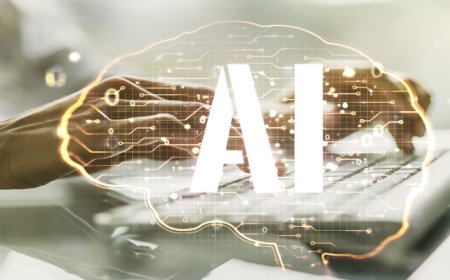The Evolution of AI: From Narrow to General AI
Explore the fascinating journey of Artificial Intelligence (AI) from narrow applications to the promising realm of General AI.

Artificial Intelligence (AI) has been a fascinating field of research and development for decades, promising to revolutionize the way we interact with technology and solve complex problems. The journey of AI has seen remarkable advancements, from basic rule-based systems to sophisticated machine learning algorithms. In this blog, we will explore the evolution of AI, tracing its transformation from narrow AI to the aspirational goal of general AI.
Narrow AI: Solving Specific Problems
Narrow AI, also known as Weak AI, refers to artificial intelligence systems that are designed to perform specific tasks or solve well-defined problems within a limited domain. Unlike General AI, which aims to possess human-like intelligence across a wide range of tasks and domains, Narrow AI is highly specialized and focused on excelling in a particular area.
Key Characteristics of Narrow AI:
-
Specialized Functionality: Narrow AI systems are designed with a narrow scope, targeting specific tasks or applications. For example, a chatbot developed to answer customer inquiries or a recommendation system suggesting personalized content on a streaming platform.
-
Task-Oriented: These AI systems are optimized to perform a particular task efficiently. They lack the capability to generalize their knowledge or skills to other unrelated tasks.
-
Limited Context Awareness: Narrow AI operates within predefined boundaries and lacks the ability to comprehend context beyond its specific domain. It relies on structured data and predefined rules or machine learning models trained on historical data.
-
High Performance in Defined Tasks: Due to their specialized nature, Narrow AI systems often exhibit high performance and accuracy in their designated tasks. They can outperform humans in specific areas, such as image recognition, natural language processing, or playing complex games like chess or Go.
-
Lack of Consciousness and Self-Awareness: Narrow AI does not possess consciousness or self-awareness. It operates based on predefined algorithms or statistical patterns and lacks human-like cognitive abilities.
While Narrow AI has shown impressive results in solving specific problems, it is essential to recognize its limitations. These AI systems lack understanding, consciousness, and the ability to transfer knowledge to new contexts. General AI, the ultimate aspiration, aims to address these limitations by creating AI systems with human-like intelligence and adaptability across diverse tasks and domains. Until then, Narrow AI continues to drive technological innovations, enhancing efficiency and convenience in various industries and enriching our daily lives.
General AI: The Quest for Human-Like Intelligence
General AI, also known as Artificial General Intelligence (AGI) or Strong AI, represents the ambitious goal of creating machines that possess human-like intelligence and cognitive abilities. Unlike Narrow AI, which is designed for specific tasks and lacks the ability to transfer knowledge to new domains, General AI aims to exhibit versatility, reasoning, creativity, and adaptability similar to human cognition.
Key Characteristics of General AI:
-
Cross-Domain Adaptability: General AI is not limited to a specific domain or task. It can apply its intelligence and knowledge to a wide range of tasks, learn from diverse experiences, and transfer knowledge from one domain to another.
-
Understanding and Learning: General AI seeks to comprehend complex concepts, abstract ideas, and relationships between different pieces of information. It can learn from limited data and generalize its knowledge to solve novel problems.
-
Reasoning and Problem-Solving: AGI can reason, analyze situations, and make informed decisions based on available information. It can apply logic, context, and critical thinking to arrive at optimal solutions.
-
Natural Language Processing: General AI has the ability to understand and generate natural language, enabling seamless communication with humans in a manner that resembles human conversation.
-
Creativity and Innovation: AGI can exhibit creative thinking, generating novel ideas, and finding innovative solutions to challenges, including tasks that it has not encountered before.
-
Social and Emotional Intelligence: General AI aims to understand human emotions, social dynamics, and exhibit empathy. This capability facilitates better human-machine interactions and understanding of human needs.
The Quest for General AI:
The journey towards achieving General AI is a complex and multidisciplinary endeavor that has captivated researchers, scientists, and visionaries for decades. The road to AGI is marked by significant challenges:
-
Understanding Consciousness: AGI requires an understanding of human consciousness, cognition, and the essence of human intelligence—a topic that remains a subject of philosophical and scientific exploration.
-
Data and Learning: Developing AGI demands large-scale, diverse, and high-quality data for training. AGI systems must learn from experiences and generalize knowledge effectively.
-
Ethical Considerations: The development of AGI raises profound ethical questions, including issues of control, transparency, bias, and ensuring that AGI aligns with human values.
-
Safety and Control: As AGI approaches human-level intelligence, ensuring its safety and control becomes crucial to prevent unintended consequences and potential risks.
The Path Forward: Challenges and Ethical Considerations
While Narrow AI has witnessed tremendous progress and widespread adoption, General AI presents formidable technical and ethical challenges. Some of the key challenges include:
-
Computational Power: Building machines with human-like cognitive abilities requires massive computational power and resources.
-
Data and Learning: AGI systems need vast amounts of diverse and high-quality data to learn effectively across multiple domains.
-
Ethical Concerns: General AI raises ethical questions, such as its potential impact on job displacement, privacy, security, and autonomy.
-
Control and Safety: Ensuring that AGI systems remain under human control and adhere to ethical guidelines is critical to avoiding unintended consequences.
The Role of AI in Society
As AI technology advances, its integration into various aspects of society becomes increasingly evident. AI-powered applications are reshaping industries such as healthcare, finance, agriculture, and transportation. AI-driven innovations are addressing complex challenges, from diagnosing diseases more accurately to optimizing supply chains and reducing energy consumption.
However, with these advancements come ethical considerations. Ensuring transparency, fairness, and accountability in AI decision-making processes is paramount. AI systems must be designed with a focus on avoiding biases and discrimination, safeguarding privacy, and providing clear explanations for their decisions.
Collaborative Efforts and Research
Developing General AI requires interdisciplinary collaboration and research. The field of AI spans computer science, cognitive science, neuroscience, ethics, philosophy, and more. Experts from various domains must come together to overcome technical challenges and address ethical concerns.
Leading organizations, including research institutions and tech giants, are investing heavily in AI research and development. Open-source initiatives and collaborative platforms are promoting knowledge sharing and accelerating progress in the field.
Narrow AI as a Stepping Stone
Narrow AI serves as a stepping stone towards General AI. As we build increasingly sophisticated Narrow AI systems, we gain valuable insights and methodologies that can potentially lead us closer to achieving human-like intelligence.
The lessons learned from Narrow AI help refine algorithms, improve data processing techniques, and enhance model performance. By iteratively improving Narrow AI, researchers inch closer to unlocking the mysteries of cognition and consciousness that underpin General AI.
The Future of AI: Possibilities and Caution
While General AI remains a distant goal, the possibilities it holds are tremendous. Human-like AI companions, personalized education, autonomous systems capable of decision-making, and solving grand challenges like climate change are just some of the potential benefits.
Yet, along with the promises come cautions. Ensuring the responsible development and deployment of General AI is essential to prevent unintended consequences. As AI systems approach human-level intelligence, the need for robust AI ethics frameworks and regulations becomes ever more crucial.
The evolution of AI from narrow to general represents an awe-inspiring journey of human ingenuity and technological progress. Narrow AI has transformed our daily lives, enhancing convenience and efficiency. However, the vision of General AI still lies ahead, demanding further research, collaboration, and ethical considerations.
As AI continues to evolve, it is essential to strike a balance between technological advancements and ethical principles. Embracing AI's potential while addressing its challenges will lead us closer to realizing the dream of General AI and usher in a new era of human-machine symbiosis, transforming how we perceive and interact with intelligent systems. The pursuit of General AI is a testament to human curiosity and determination to push the boundaries of what is possible, and as we embark on this transformative journey, we must remain steadfast in our commitment to responsible AI development.











































